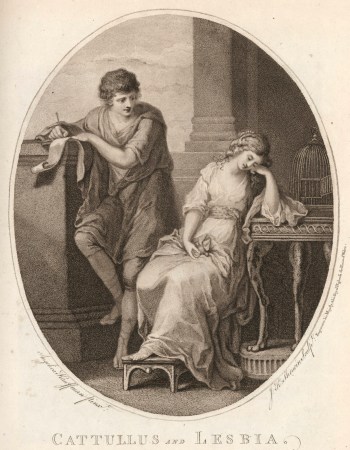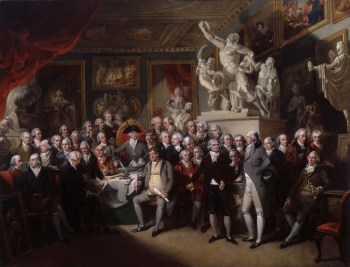Angelica Kauffman RA (1741 - 1807)
RA Collection: People and Organisations
The internationally celebrated painter Angelica Kauffman spent 15 years in England, making a significant impact on the London art scene as one of only two female Founder Members of the Royal Academy.
Born in Chur, Switzerland in 1741, Kauffman trained with her father, the Austrian painter Joseph Johann Kauffman, and was recognised as a child prodigy. The family moved between Austria, Switzerland and Italy where she established a reputation as an artist and was elected a member of the Roman Accademia di San Luca at the age of just 23. Although, as a woman, Kauffman was not able to officially enrol at an art academy she nevertheless studied the works of the Old Masters and classical sculpture at first hand. In Italy, she mixed with neoclassical artists and scholars and also met many Grand Tourists. Her popularity among the community of British visitors and expatriates there encouraged her to move to London in 1766.
Soon after arriving in London, Kauffman established a close friendship with Joshua Reynolds, commemorated in the portraits they painted of each other. She also gained a commission to paint Princess Augusta, sister of King George III, and subsequently Queen Charlotte. Her friendship with Reynolds and other artists, along with Royal approval helped to ensure that when the Royal Academy of Arts was established in December1768, Kauffman was among the group of 36 Founder Members (along with one other woman, the painter Mary Moser). Kauffman was in great demand as a portraitist in London but she identified herself primarily as a history painter, the genre Reynolds placed at the heart of the Royal Academy’s teaching. She exhibited history paintings each year at the Royal Academy’s influential annual exhibitions, displaying her erudition by depicting scenes from a wide range of mythologicial, literary and historical sources.
In 1775 Kauffman threatened to leave the Royal Academy due to a dispute about a satirical painting by Nathaniel Hone in the annual exhibition. The Conjuror was a thinly-veiled satire on Reynolds’ working methods but it also took aim at Kauffman (finished version http://onlinecollection.nationalgallery.ie/objects/3257/the-conjuror and the oil sketch https://www.tate.org.uk/art/artworks/hone-sketch-for-the-conjuror-t00938 ). The child at the conjuror’s knee resembles the figure in Kauffman’s painting Hope and, worse still, in the background Hone included a group of naked artists cavorting outside St Paul’s Cathedral. The only female figure in the group represents Kauffman as this scene referred to the painters, Kauffman among them, who were part of a cancelled project to paint the cathedral. The Academy initially prevaricated but when Kauffman said she that she would leave the institution if the painting was not removed the matter was put to a vote. Kauffman won and Hone was asked to remove the offending painting.
In the late 1770s, Kauffman was commissioned by the Royal Academy to paint a set of four ceiling paintings depicting the ‘Elements of Art’, to be displayed in the Council Room of New Somerset House which opened in 1780. A visual representation referencing the theories that Reynolds set out in his Discourses on Art, the four oval paintings present four female figures as Invention, Composition, Design and Colour. The ceiling paintings are usually on display in the Front Hall of Burlington House but they have been taken down for inclusion in the Academy’s forthcoming exhibition on Kauffman https://www.royalacademy.org.uk/exhibition/angelica-kauffman and Tate Britain’s ‘Now You See Us: Women Artists in Britain 1520-1920’.
Kauffman left London in 1781 to settle in Rome. Returning to Italy at the height of her career, she established an international clientele and a famous salon which attracted celebrated visitors including Goethe and Canova. Kauffman kept up her connections with her many British friends and patrons, continuing to exhibit at the Royal Academy, sending commissions back to the UK and painting Grand Tourists visiting Rome. She continued to develop her practice as both a portraitist and a history painter in Rome, demonstrating even greater confidence and skill in both genres. She painted several accomplished self-portraits during her years in Rome, including one looking back on the choice she made as a young woman between pursuing a career in painting or in music https://www.nationaltrustcollections.org.uk/object/960079.
When Kauffman died in 1807, her grand funeral in Rome was arranged by the famous sculptor Antonio Canova and a bust of the artist, sculpted by her cousin Johann Peter Kauffmann, was subsequently placed in the Pantheon, beside that of Raphael. The funeral itself was described in a letter sent to the Royal Academicians in London and read out in their General Assembly https://www.royalacademy.org.uk/art-artists/archive/letter-from-joseph-bonomi-76-great-titchfield-street-to-benjamin-west?artistid=9808&form=archives&index=4&totalentries=20.
Profile
Foundation Member
Born: 30 October 1741 in Coire, Switzerland
Died: 5 November 1807
Nationality: Swiss
Elected RA: 10 December 1768
Gender: Female
Preferred media: Painting
Works by Angelica Kauffman in the RA Collection
13 results
-
![Angelica Kauffman RA, Woman resting her head on a book]()
Angelica Kauffman RA
Woman resting her head on a book, 1770
Etching
-
![Angelica Kauffman RA, Invention]()
Angelica Kauffman RA
Invention, 1778-80
Oil on canvas
-
![Angelica Kauffman RA, Composition]()
Angelica Kauffman RA
Composition, 1778-80
Oil on canvas
-
![Angelica Kauffman RA, Design]()
Angelica Kauffman RA
Design, 1778-80
Oil on canvas
-
![Angelica Kauffman RA, Colouring]()
Angelica Kauffman RA
Colouring, 1778-80
Oil on canvas
-
![Angelica Kauffman RA, A scene from the story of Rhodope and King Psammetichus of Egypt]()
Angelica Kauffman RA
A scene from the story of Rhodope and King Psammetichus of Egypt, 1780
Pen and ink and wash on cream laid paper
-
![Angelica Kauffman RA, Cow]()
Angelica Kauffman RA
Cow, 1762-1807
Etching
-
![Angelica Kauffman RA, Telemachus at the Court of Sparta]()
Angelica Kauffman RA
Telemachus at the Court of Sparta, 1770
-
![Angelica Kauffman RA, Lady in a Turkish Dress]()
Angelica Kauffman RA
Lady in a Turkish Dress, 1775
Printed in sanguine.
-
![Angelica Kauffman RA, Ariadne abandoned by Theseus]()
Angelica Kauffman RA
Ariadne abandoned by Theseus, 1778
-
![Angelica Kauffman RA, Sappho composing an ode to Venus]()
Angelica Kauffman RA
Sappho composing an ode to Venus, 1778
-
![Angelica Kauffman RA, Diana Preparing for Hunting]()
Angelica Kauffman RA
Diana Preparing for Hunting, 1780
Stipple engraving
-
![Angelica Kauffman RA, Her Majesty Queen Charlotte raising the Genius of the Fine Arts]()
Angelica Kauffman RA
Her Majesty Queen Charlotte raising the Genius of the Fine Arts, Published 19 May 1772
Mezzotint
Works after Angelica Kauffman in the RA Collection
15 results
-
![Angelica Kauffman RA, Helen]()
After Angelica Kauffman RA
Helen, 24 July 1776
Stipple engraving
-
![Angelica Kauffman RA, Catullus and Lesbia]()
After Angelica Kauffman RA
Catullus and Lesbia, 16 October 1784
Stipple engraving
-
![Angelica Kauffman RA, Portrait of Elizabeth (Vernon), Countess of Harcourt]()
After Angelica Kauffman RA
Portrait of Elizabeth (Vernon), Countess of Harcourt, 1 October 1784
Stipple engraving
-
![Angelica Kauffman RA, Self-portrait personifying Painting]()
After Angelica Kauffman RA
Self-portrait personifying Painting, May 1783
Stipple-engraving
-
![Angelica Kauffman RA, Angelica and Sacripante]()
After Angelica Kauffman RA
Angelica and Sacripante, 1783
Line engraving
-
![Angelica Kauffman RA, Self-portrait]()
After Angelica Kauffman RA
Self-portrait, 1 May 1809
Stipple engraving
-
![Angelica Kauffman RA, Portrait of Mrs Anne Damer with emblems of Fame and Sculpture]()
After Angelica Kauffman RA
Portrait of Mrs Anne Damer with emblems of Fame and Sculpture
Stipple engraving
-
![Angelica Kauffman RA, The Nursing of Bacchus]()
After Angelica Kauffman RA
The Nursing of Bacchus, 20 February 1791
Stipple engraving
-
![Angelica Kauffman RA, Self-portrait]()
After Angelica Kauffman RA
Self-portrait, 1 May 1809
Stipple engraving
-
![Angelica Kauffman RA, The Three Fine Arts]()
After Angelica Kauffman RA
The Three Fine Arts, 10 November 1783
Stipple engraving
-
![Angelica Kauffman RA, Self-portrait]()
After Angelica Kauffman RA
Self-portrait, ca. 1805?
Line engraving
-
![Angelica Kauffman RA, Mourners at a Tomb]()
After Angelica Kauffman RA
Mourners at a Tomb, 1 February 1781
Stipple-engraving
-
![Jean-Marie Delatre, Dido invoking the Gods]()
Jean-Marie Delatre
Dido invoking the Gods, 15 March 1784
Stipple-engraving and etching
-
![Jean-Marie Delatre, Penelope weeping over the bow of Ulysses]()
Jean-Marie Delatre
Penelope weeping over the bow of Ulysses, 15 March 1784
Stipple-engraving and etching
-
![Angelica Kauffman RA, Engraved frontispiece (Angelica Kauffman self-portrait) and letterpress title-page]()
After Angelica Kauffman RA
Engraved frontispiece (Angelica Kauffman self-portrait) and letterpress title-page, 1781
Etching and engraving ; letterpress
Works associated with Angelica Kauffman in the RA Collection
4 results
-
![Jean-Marie Delatre, A scene from the story of Rhodope and King Psammetichus of Egypt]()
Jean-Marie Delatre
A scene from the story of Rhodope and King Psammetichus of Egypt, 1 May 1780
Etching and engraving
-
![John Hamilton Mortimer ARA, Bacchanal]()
John Hamilton Mortimer ARA
Bacchanal, 1762-1807
Etching
-
![Unidentified artist, Portrait of Angelica Kauffman RA]()
After Unidentified artist
Portrait of Angelica Kauffman RA
Stipple engraving
-
![Henry Singleton, The Royal Academicians in General Assembly]()
Henry Singleton
The Royal Academicians in General Assembly, 1795
Oil on canvas
Associated books
7 results
-
Giovanni Gherardo De Rossi
Vita Di Angelica Kauffmann Pittrice Scritta Dal Cav. Giovanni Gherardo De Rossi - Firenze: [1810]
05/2404
-
A Collection Of Prints, From Pictures Painted For The Purpose Of Illustrating The Dramatic Works Of Shakspeare, By The Artists Of Great-Britain. Volume I. (II.) - London,: [1803]
04/3171
-
Richard Morton Paye
Etchings, by & from the most esteem'd English artists - [s.l.]: c.1875]
05/341
-
Léon de Wailly
Angelica Kauffmann Par Léon De Wailly. Tome Premier (Second) - Paris: 1859 Droit de traduction réservé
05/3592
Associated archives
21 results
-
James Northcote, Rome, to Saml. Northcote, Plymouth, Devonshire, England
29 May 1779
Item NOR/50
-
![, Kauffman: memoria delle pitture]()
Kauffman: memoria delle pitture
1781-1798
Fonds KAU
-
James Northcote, Argyll Place, to J. H. Burn
22 Sep 1827
Item JU/2/136
-
Angelica Kauffman, Golden Square [to an unidentified recipient]
19 Feb 1777
Item JU/1/73
































